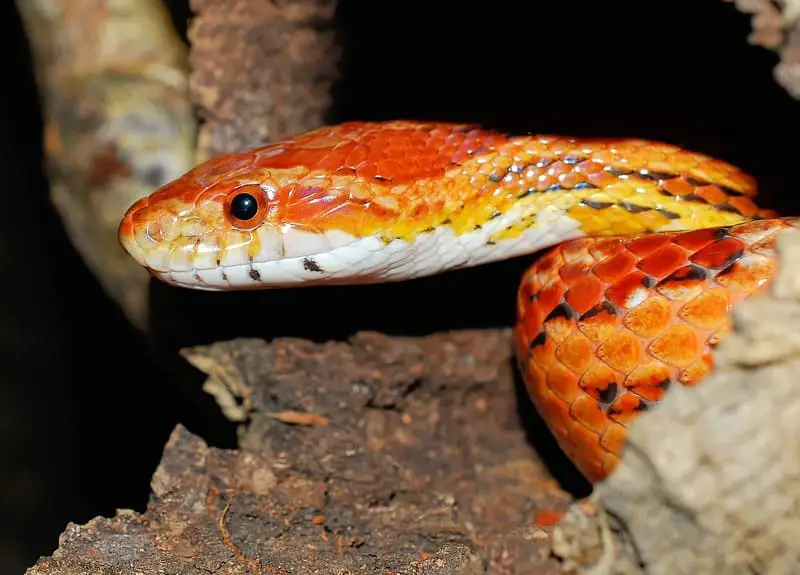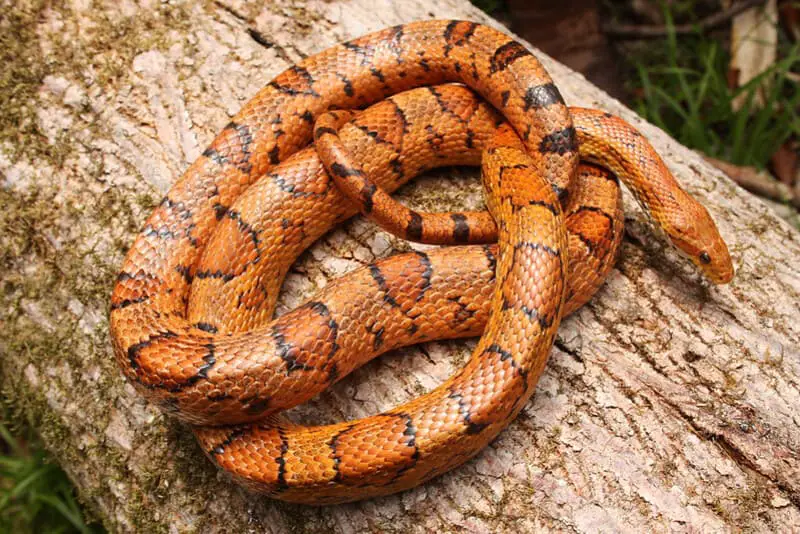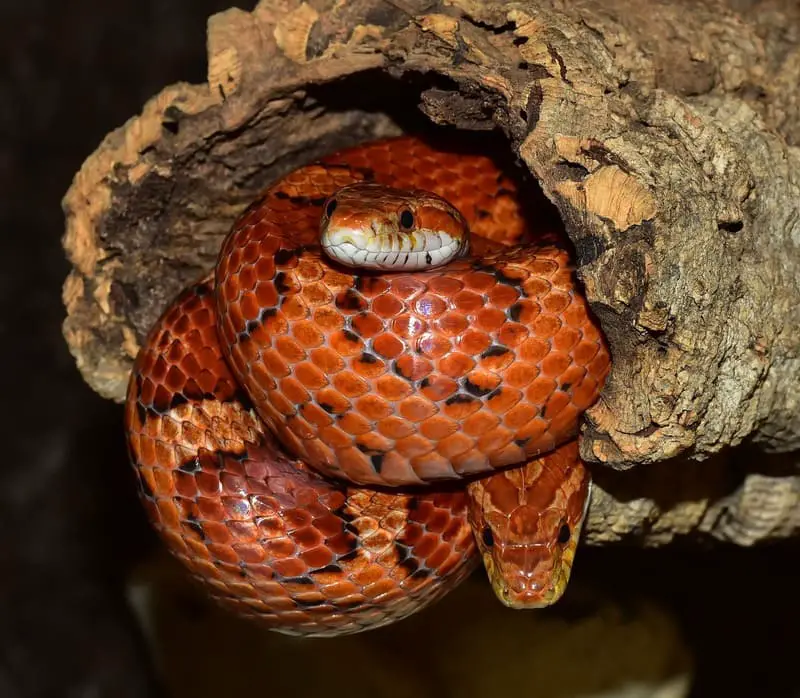Corn snakes (Pantherophis guttatus) are popular and attractive pet snakes, known for their manageable size, docile nature, and beautiful color variations. Understanding the behavior and activity patterns of corn snakes is crucial for their proper care and wellbeing. One common question that often arises among keepers and enthusiasts is whether corn snakes are nocturnal. In this comprehensive guide, we will explore the activity patterns and behaviors of corn snakes, including their diurnal and nocturnal tendencies.

Corn Snake Basics
Before diving into the topic of corn snake activity patterns, it’s essential to understand some fundamental aspects of these reptiles.
Natural Habitat
Corn snakes are native to North America, specifically the southeastern United States. They inhabit a range of environments, including forests, grasslands, and abandoned buildings. Their natural range is quite extensive, allowing them to adapt to various conditions.
Physical Characteristics
Corn snakes are medium-sized snakes, with adults typically reaching lengths between 3 to 5 feet. They have slender bodies and are known for their vibrant and diverse color patterns. Their name “corn snake” is thought to have originated from the resemblance of their belly scales to Indian maize or corn.
Behavior
Corn snakes are generally docile and not prone to aggression. They are skilled climbers and may escape from enclosures if not securely contained. When threatened, they may exhibit defensive behaviors, such as hissing, vibrating their tails, or striking. However, their primary response is to flee or hide.
Diet
In the wild, corn snakes primarily feed on small mammals like rodents. As pets, they can be fed a diet of appropriately-sized mice, rats, or other small prey items. Feeding frequency varies with the age and size of the snake.
Diurnal vs. Nocturnal vs. Crepuscular
To determine whether corn snakes are nocturnal, it’s important to understand the terms used to describe different activity patterns in animals:
- Diurnal: Diurnal animals are active during the daytime and typically rest or sleep at night. They have adapted to function optimally during daylight hours and may have specialized adaptations for activities like hunting, foraging, or sunbathing.
- Nocturnal: Nocturnal animals are active primarily during the night. They have special adaptations for low-light or nighttime activities, such as enhanced night vision and sensory perception. Nocturnal animals often rest or sleep during the day.
- Crepuscular: Crepuscular animals are most active during the dawn and dusk, which are the low-light periods at the beginning and end of the day. These animals are adapted to exploit the transitional periods when their prey or predators are active.
Understanding these terms helps in determining the activity patterns of corn snakes.

The Activity Patterns of Corn Snakes
Corn snakes are primarily crepuscular, which means they are most active during the dawn and dusk. This crepuscular behavior aligns with their natural hunting and foraging patterns. In the wild, they are more likely to be on the move during these transitional periods when the lighting conditions are favorable for their activities.
Crepuscular Behavior
The crepuscular behavior of corn snakes is a survival strategy that allows them to take advantage of their prey’s activity patterns. Small mammals, which are their primary food source, are often active during dawn and dusk. By being crepuscular, corn snakes increase their chances of encountering and capturing prey.
This crepuscular nature also helps corn snakes avoid the extreme temperatures of the day in their native habitats. During the scorching heat of the day, they may seek shelter and remain relatively inactive to conserve energy and avoid desiccation. In the evening and early morning, when temperatures are more favorable, they become more active.
Daytime Resting
While corn snakes are crepuscular and most active during dawn and dusk, it is not accurate to describe them as strictly nocturnal. During the daytime and nighttime hours outside of their peak activity periods, corn snakes often rest and seek shelter. This resting behavior is a common trait among many snake species, allowing them to conserve energy and remain hidden from potential predators.
Captive Behavior
In captivity, the activity patterns of corn snakes may be influenced by various factors, including their environment, feeding schedule, and interactions with their keepers. Some corn snakes may adjust to a more diurnal or nocturnal schedule, depending on their experiences. For example, if a corn snake is frequently handled during the day or is exposed to daytime lighting for extended periods, it may become more active during daylight hours.
However, even in captivity, corn snakes tend to retain their crepuscular tendencies. Keepers may notice increased activity, such as exploring their enclosure or hunting behavior, during the early morning or evening hours.
The Role of Light and Temperature
Light and temperature are essential environmental factors that influence the activity patterns of corn snakes. These factors play a significant role in regulating the snake’s behavior, both in the wild and in captivity.
1. Light
Light is a critical cue for many animals, including reptiles. It influences their daily rhythms and behaviors. In the wild, the changing intensity of natural light throughout the day signals the timing of activities. For corn snakes, the subdued light of dawn and dusk prompts increased activity during these transitional periods.
In captivity, artificial lighting can affect a corn snake’s activity. Exposure to bright, consistent lighting during the daytime may encourage more diurnal behavior. On the other hand, dim lighting or darkness during the day is likely to promote crepuscular behavior. Many reptile keepers provide a day-night cycle by using timers to simulate natural light conditions, which can help maintain the snake’s natural activity patterns.
2. Temperature
Temperature also plays a pivotal role in regulating the behavior of corn snakes. These reptiles are ectothermic, meaning they rely on external heat sources to regulate their body temperature. Temperature affects their metabolic rate, digestion, and overall activity.
In the wild, corn snakes often seek out warmer areas during the daytime and cooler spots during the evening and nighttime. This behavior is driven by the need to regulate their body temperature efficiently. In captivity, maintaining appropriate temperature gradients in the snake’s enclosure is crucial. Providing a thermal gradient allows the snake to choose the temperature that best suits its activity and digestion needs.
3. Seasonal Variations
In their natural habitats, corn snakes may exhibit seasonal variations in their activity patterns. For example, they tend to be more active during the breeding season and less active during the colder winter months. These changes are influenced by environmental factors such as temperature and photoperiod (day length). In captivity, keepers may also observe seasonal variations in their snakes’ behavior.

Behavior When Housed
When kept as pets, corn snakes often adapt to the routines and conditions provided by their keepers. The activity patterns of captive corn snakes can vary depending on several factors:
1. Lighting
As mentioned earlier, the lighting conditions in the enclosure play a significant role in regulating a corn snake’s activity patterns. Providing a day-night cycle with appropriate lighting can help maintain crepuscular behavior.
2. Temperature
A well-maintained temperature gradient within the enclosure ensures that the snake can select the ideal temperature for its activities. Corn snakes may become more active when provided with an appropriately warm basking area and a cooler section for resting.
3. Feeding Schedule
The feeding schedule can also influence a captive corn snake’s activity. They tend to be more active before and after feeding, as these periods align with their natural hunting and foraging behavior. It’s important to avoid handling or disturbing the snake immediately after feeding, as this can lead to regurgitation.
4. Handling
Regular handling by the keeper can have an impact on a corn snake’s behavior. While these snakes are generally docile and tolerate handling well, frequent or rough handling can cause stress and may affect their activity patterns.
5. Age and Health
The age and health of the snake also play a role in its activity. Younger corn snakes are often more active and curious, while older individuals may be more sedentary. The overall health and condition of the snake can also influence its behavior.
6. Cage Enrichment
Providing an enriched environment with hiding spots, climbing opportunities, and novel objects can stimulate a corn snake’s natural behaviors. These enrichments can encourage exploratory behavior and physical activity.
Myth: Corn Snakes Are Strictly Nocturnal
One common myth about corn snakes is that they are strictly nocturnal. This myth likely arises from their tendency to be most active during dawn and dusk. While they are indeed crepuscular, their activity patterns are not limited to the nighttime hours. They can also be active during the daytime and rest at night or during the day, depending on various factors as discussed earlier.
The Importance of Understanding Activity Patterns
Understanding the activity patterns of corn snakes is crucial for their proper care and wellbeing, whether they are kept as pets or encountered in the wild. Here are some reasons why this understanding is important:
1. Temperature and Lighting
Proper temperature and lighting regulation in the enclosure is essential for the snake’s health and comfort. Knowing when the snake is most active helps ensure that these conditions are suitable during those periods.
2. Feeding Schedule
Feeding a corn snake when it is most active, typically before or after dawn or dusk, can help replicate their natural foraging behavior and improve feeding success.
3. Handling and Enrichment
Being aware of the snake’s activity patterns can guide the timing of handling and the introduction of environmental enrichments. Handling during times of activity may result in a more responsive and engaged snake.
4. Observation and Monitoring
Understanding when the snake is active allows keepers to observe their behavior, monitor health, and notice any unusual changes or signs of distress.
5. Breeding Behavior
For those interested in breeding corn snakes, knowing their activity patterns is essential for timing breeding attempts and monitoring reproductive behavior.
Conclusion
Corn snakes are primarily crepuscular, meaning they are most active during the dawn and dusk. While they are not strictly nocturnal, their activity patterns may vary depending on factors such as lighting, temperature, age, and health. Understanding these patterns is crucial for providing proper care and maintaining their wellbeing in captivity. Responsible snake keepers take into account the natural behavior of their pets and provide suitable conditions that align with their crepuscular tendencies. By doing so, they can ensure that their corn snakes thrive and exhibit their natural behaviors in captivity.
